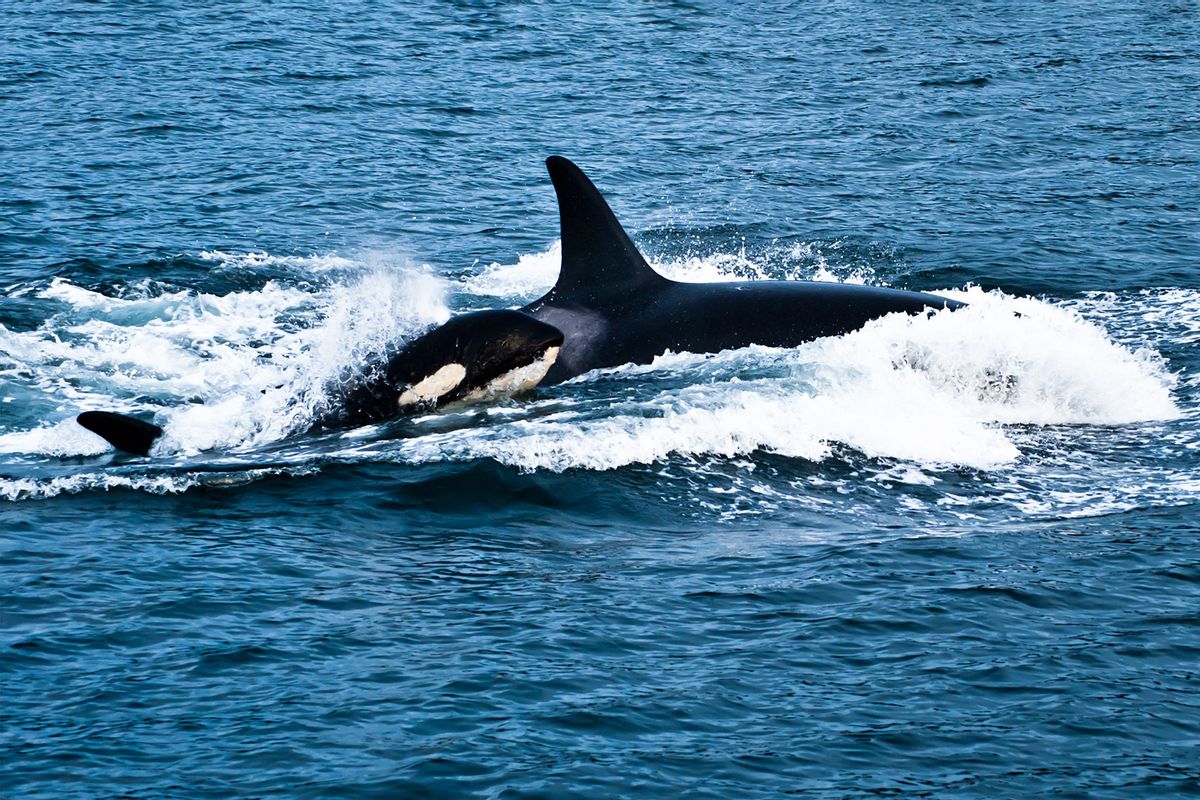For the first time, a team of whale experts have recorded an orca caring for the offspring of another species, a long-finned pilot whale infant. With their iconic black and white markings, orcas (Orcinus orca), also known as killer whales, are an iconic sea mammal thanks to the 1993 film "Free Willy" and their controversial presence at Sea World. In contrast, long-finned pilot whales (Globicephala melas) are less charismatic dolphins, colored a rubbery gray with a head like a lumpy bowling ball.
Both killer whales and pilot whales have something in common in that they're both technically dolphins, not whales, and they share some of the same ocean. But they don't always seem to get along. Pilot whales have been observed harassing orcas, and chasing them off, though not attacking them. The killer whales have usually responded by fleeing or passively moving away.
For 21 minutes on August 12, 2021, cetologists (marine biologists that study whales and dolphins), observed three orcas interacting with a long-finned pilot whale calf. This trio of killer whales has been observed 21 times in the decade since 2012, usually munching on Atlantic herring, but always together. This indicates a stable group structure and suggests they might be related. In other words, a regular dolphin family. Scientists even gave them nicknames: the two adult female orcas are called Dragonfly and Sædís, and the lone adult male is named Zale.
Sædís, also known by the identifier SN0540, has never been known to be pregnant or have given birth. But for some reason, during this interaction almost two years ago (but only written up recently), a team of cetologists from the West Iceland Nature Research Centre were on a boat west of the Snæfellsnes Peninsula in Iceland when they noticed a pilot whale calf closely following her — a behavior never recorded before.
Sædís kept the calf close by while the other two killer whales were feeding. There were no other pilot whales in sight, and Sædís had the infant in echelon position, tucked beneath the orca's mid-lateral flank, which is indicative of nurturing behavior. Baby dolphins can't swim as fast as their mothers, so in this position, they are given "hydrodynamic benefits," which allows them to keep up with the pod.
"The observation of the echelon formation between the adult female killer whale SN0540 and the pilot whale calf should be given special consideration, even though the pilot whale calf was not observed nursing," the authors wrote. "The echelon position allows a calf to make fewer tail fluke movements than when swimming on its own and overcome physical limitations during high-speed travel, as it is closely 'drafting' alongside an individual, carried by the pressure wave created by the adult's larger body."
This behavior is pretty energy intensive, so the fact that Sædís was doing it isn't trivial. Only lactation or breast-feeding is considered more demanding of an energy budget, which wild animals have to consider in order to best evade predators and hunt efficiently.
In other words, Sædís was spending precious energy keeping this baby pilot whale around. Unfortunately, it doesn't seem like this calf was very healthy. The researchers described it as "emaciated," or thin and weak due to lack of nutrition. There's no evidence to suggest Sædís was able to nurse it and when the whale trio was spotted again in March 2022, the calf was gone.
Want more health and science stories in your inbox? Subscribe to Salon's weekly newsletter The Vulgar Scientist.
The researchers have no idea how this relationship got started or how long it lasted. "Whether the attraction between SN0540 and the pilot whale calf was mutual or one-sided is not known, nor is the duration of the association, or how it started and ended," they wrote.
Nonetheless, it is indicative of epimeletic behavior, meaning caring for a dead, dying or weakened individual. For example, Marie-Thérèse Mrusczok, one of the study authors and the founder and president of Orca Guardians Iceland, an independent conservation nonprofit, has previously reported an orca that carried its dying (and later, dead) calf for five consecutive days.
But doing something similar for another species is unheard of in orcas. Other dolphins have been observed taking care of young from other species. For instance, a female Indian Ocean humpback dolphin was observed, on two separate occasions, taking care of a newborn Indo-Pacific bottlenose dolphin and a newborn short-beaked common dolphin. This puzzling behavior prompted researchers to ask the question: was this dolphin kidnapping other dolphins?
With Sædís, no one knows for sure if this another case of one dolphin stealing the young of a different species. Or it could have been an instance of "foster care," with the calf returned to its mother the next time the orcas met with some pilot whales. Given the poor health of the infant, it may be more likely that the baby dolphin was simply orphaned.
This incident leaves a lot of unanswered questions, but we do know orcas are highly intelligent, with the second largest brains of all marine mammals. Their family dynamics are just beginning to become clear, as a study published last month in the journal Current Biology reveals they constitute an "extreme example of extended maternal care." Using five decades of census data, researchers studying orcas in the North Pacific reported that killer whale moms take care of their sons for years after reaching adulthood, even at the significant expense of not having more kids.
There is some parallel here between adult men who never move out of their mother's basements, but the whole situation is another mystery of orca behavior. Why these intelligent creatures take care of less capable individuals in or outside their own species is still an enigma.



Shares